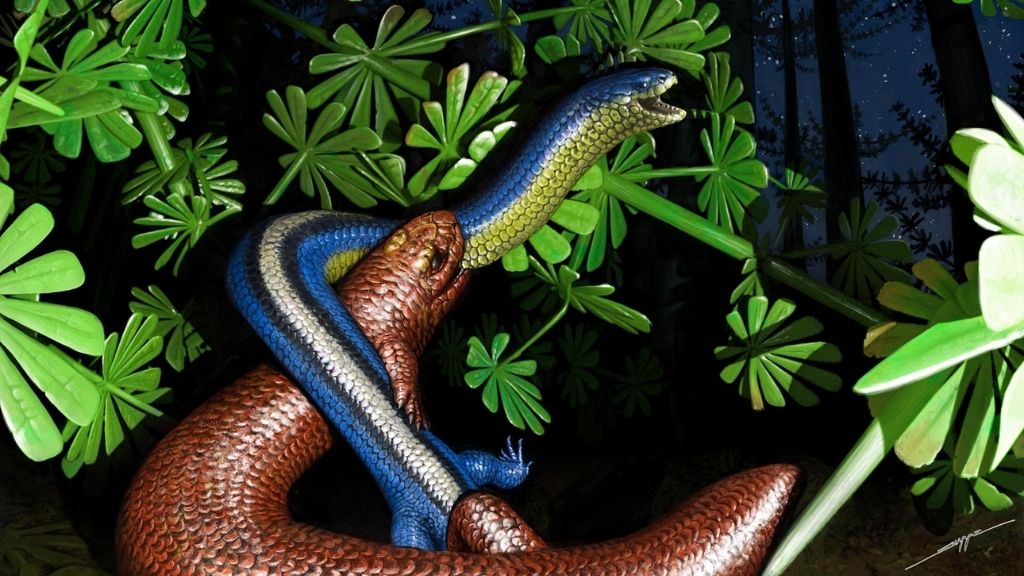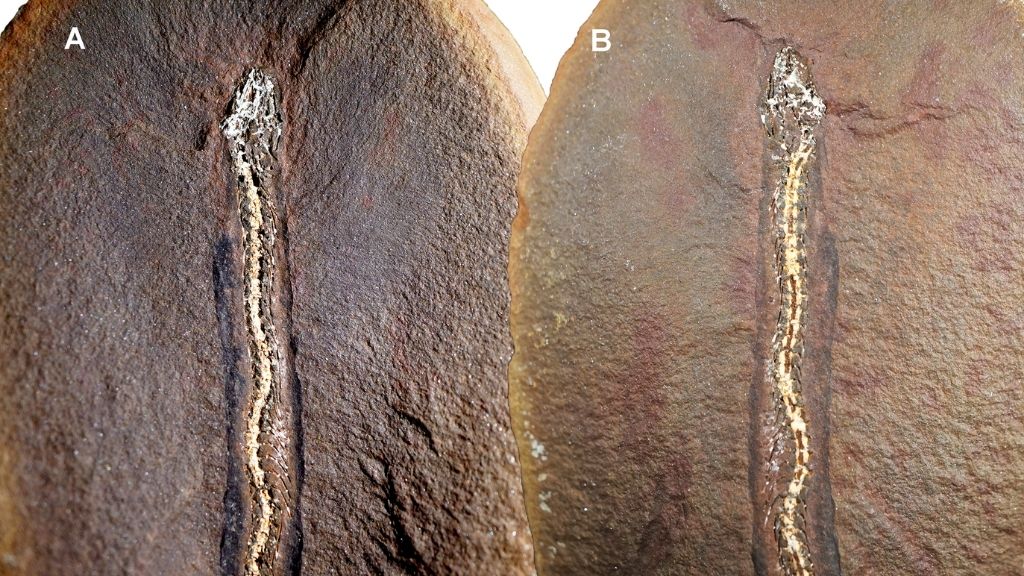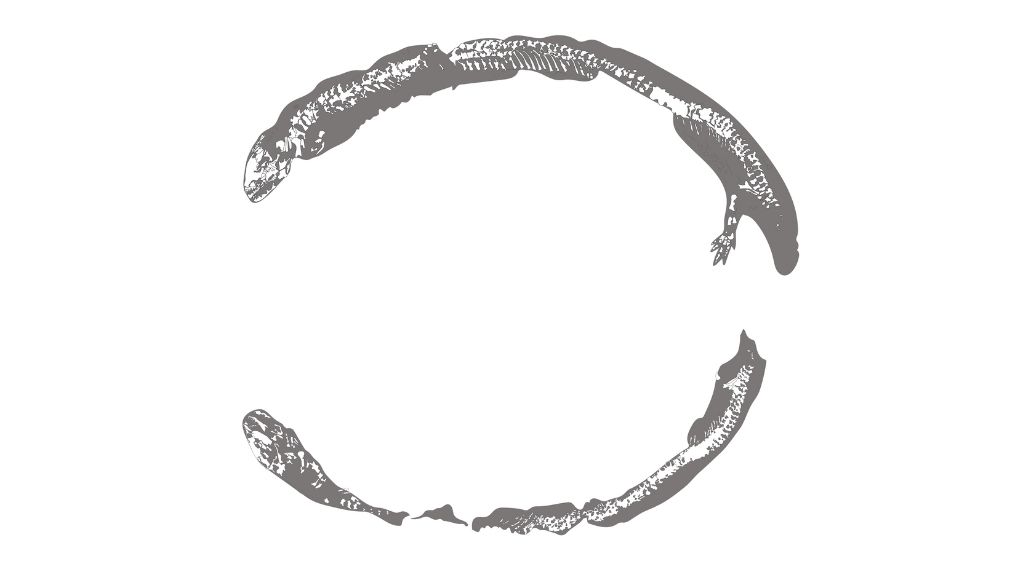Weird ancient snakelike fossil caught in the act of losing its legs
The long, skinny animal had two tiny back legs.

Two 308 million-year-old fossils show creatures caught in evolutionary limbo between two forms: lizard-like and snake-like. The animals' sinuous, serpentine bodies have no front limbs, but sport two teeny lizard legs in the back.
Scientists recently identified these unique fossils as a newfound genus and species, which they named Nagini mazonense in a new study published Monday (March 28) in the journal Nature Ecology & Evolution. The specimens represent the earliest known examples of evolutionary limb loss in amniotes — animals that produce embryos protected by an amniotic sac, a group that includes mammals, birds and reptiles.
It's rare to find such transitional forms in the fossil record, to "catch something in-between'' a four-limbed animal and limbless animal, lead study author Arjan Mann, a vertebrate paleontologist and postdoctoral fellow at the Smithsonian National Museum of Natural History (NMNH) in Washington, D.C., told Live Science.
N. mazonense belongs to a group of long, thin animals called the molgophids, the authors determined. Previously, Mann and other researchers had identified a few molgophid fossils that had shortened forelimbs with missing digits, but N. mazonense is the first member of the group with completely absent forelimbs and a missing pectoral girdle, the bony structure that would normally connect the forelimbs to the skeleton.
Related: 10 coolest non-dinosaur fossils unearthed in 2021

"It's different than anything else we knew," Mann said of the newly-named creature.
The two N. mazonense fossils were originally excavated from the Mazon Creek Lagerstätte, a famous fossil site in northeastern Illinois that is about 309 million to 307 million years old, meaning it dates back to the Carboniferous period. An expansive estuary once covered the region, and its soft, claylike sediments would often bury animals that would then fossilize, Mann said. Mazon Creek fossils are typically found encased in lumps of siderite, an iron carbonate mineral, and are exceptionally well preserved, according to NMNH.
Sign up for the Live Science daily newsletter now
Get the world’s most fascinating discoveries delivered straight to your inbox.
Both N. mazonense fossils that were described in the new study were found in a specific area within the Mazon Creek Lagerstätte called Pit 11, where there was once a coal mine, Mann said. They were then housed in two different museums: the Milwaukee Public Museum (MPM) in Wisconsin and the Field Museum of Natural History in Chicago.
The fossil in the Milwaukee collection included the front half of the animal's skeleton, while the fossil housed in Chicago was significantly more complete and "preserves substantial remains of soft tissue in addition to the skeleton," Mann and his colleagues reported. Based on impressions left by soft tissue in the surrounding stone, the team determined that N. mazonense likely had a rounded snout that was well suited for head-first burrowing. The Field Museum's fossil also retained its rear pelvic girdle and one hindlimb with four tiny toes.
Based on the relative sizes of the two specimens, the team determined the MPM fossil to be an adult and the Field Museum's to be a juvenile. The scientists estimated that a fully grown adult N. mazonense could grow to be about 4 inches (10 centimeters) long, with 85 vertebrae and 85 pairs of ribs. Because the animals lacked front limbs, the study authors hypothesized that the creatures mostly moved by sidewinding — a wave-like motion seen in some modern snakes — and potentially used their back legs to stabilize their bodies while burrowing, Mann said.
Related: Scientists uncover new mode of evolution
Mann previously described two related creatures that had been excavated from Mazon Creek, naming these molgophids Diabloroter (meaning "devil digger") and Infernovenator ("hell hunter"), according to a 2019 statement from Carleton College in Canada, where Mann was at the time pursuing his doctorate. These other fossils showed signs of progressive limb shortening and loss of digits; in fact, the animal called Infernovenator steenae retained only one bone in its forelimb, Mann wrote in a statement accompanying the new study.

"This hints that overall reduction of limb size and loss of distal limb modules may have preceded complete loss of the limb," as seen in N. mazonense, Mann wrote. And although N. mazonense and other molgophids are not ancestors of modern snakes, this pattern of limb loss parallels some aspects of snake evolution.
Specifically, in the early stages of modern snake evolution, snakes initially lost their front limbs and front pectoral girdles before losing their back limbs, just like the molgophids did. This hints that this snake-like pattern of "forelimb-first" limb loss is not actually unique to snakes, but instead appeared in some of the earliest branches of the amniote tree of life, Mann told Live Science.
"Snake embryos, such as pythons, still form hindlimb buds that disappear during development," Rolf Zeller, a research group leader at the University of Basel in Switzerland who was not involved in the study, told New Scientist. "The discovery of an ancient snakelike fossil lacking forelimbs but retaining hindlimbs is a fantastic find, because it reveals the existence of transitional forms before complete limb loss during evolution."
Originally published on Live Science.

Nicoletta Lanese is the health channel editor at Live Science and was previously a news editor and staff writer at the site. She holds a graduate certificate in science communication from UC Santa Cruz and degrees in neuroscience and dance from the University of Florida. Her work has appeared in The Scientist, Science News, the Mercury News, Mongabay and Stanford Medicine Magazine, among other outlets. Based in NYC, she also remains heavily involved in dance and performs in local choreographers' work.









